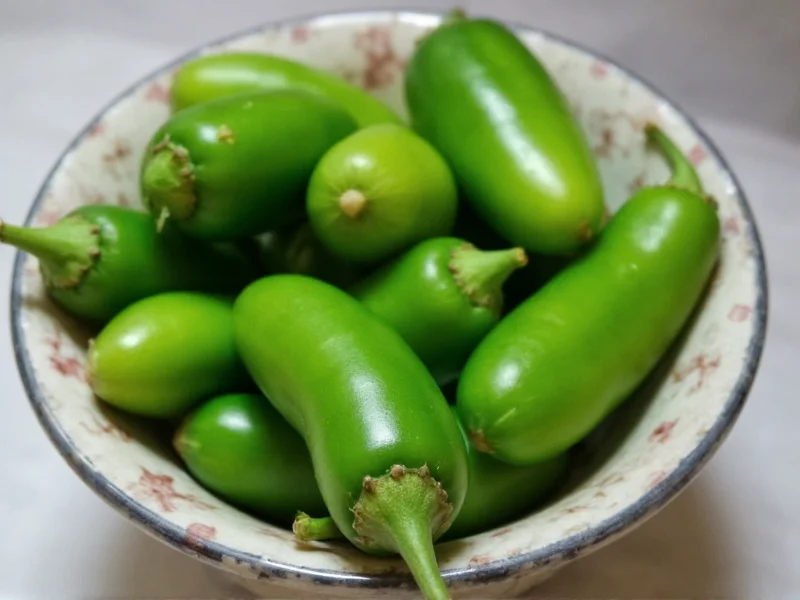Understanding exactly how many SHU is a jalapeno requires examining both the standard measurement range and the factors that cause variation in heat levels. The Scoville scale, developed by pharmacist Wilbur Scoville in 1912, measures the concentration of capsaicinoids—the compounds responsible for a pepper's heat.
What Determines Jalapeño Heat Levels?
Jalapeños don't have a single fixed SHU value because multiple factors influence their spiciness. These variables explain why you might find some jalapeños mild while others deliver significant heat.
| Factor | Impact on SHU | Explanation |
|---|---|---|
| Genetics | Varies by cultivar | Different jalapeño varieties (like 'Early Jalapeño' or 'Jalafuego') have genetically determined heat ranges |
| Climate | ↑ Heat in hotter/drier conditions | Stress from heat and water scarcity increases capsaicin production |
| Ripeness | ↑ Heat as it ripens | Red jalapeños (fully ripe) are typically hotter than green ones |
| Soil Conditions | ↑ Heat in nutrient-poor soil | Peppers produce more capsaicin when stressed by poor growing conditions |
| Seed Placement | Seeds/membranes = hottest parts | Most capsaicin concentrates in the white pith surrounding seeds |
Jalapeño SHU Compared to Other Common Peppers
Understanding how hot is a jalapeno in SHU becomes clearer when comparing it to other peppers. This context helps cooks and spice enthusiasts gauge what to expect:
| Pepper Type | Scoville Heat Units (SHU) | Relative Heat Level |
|---|---|---|
| Bell Pepper | 0 SHU | Mild (no heat) |
| Pepperoncini | 100-500 SHU | Very mild |
| Poblano | 1,000-2,000 SHU | Mild |
| Jalapeño | 2,500-8,000 SHU | Medium |
| Serrano | 10,000-23,000 SHU | Hot |
| Habanero | 100,000-350,000 SHU | Very hot |
| Ghost Pepper | 855,000-1,041,427 SHU | Extreme |
Practical Implications of Jalapeño Heat Range
Knowing the SHU value of a jalapeno matters for several practical reasons:
Cooking Applications
Chefs and home cooks need to understand that jalapeños offer moderate heat that enhances dishes without overwhelming them. The 2,500-8,000 SHU range makes them versatile for salsas, nachos, stuffed peppers, and as a pizza topping. Removing seeds and membranes can reduce heat by up to 80%, allowing customization of spice levels.
Gardening Considerations
Gardeners selecting jalapeño varieties should recognize that how many Scoville units in a jalapeno depends partly on growing conditions. If you prefer milder peppers, provide consistent water and rich soil. For hotter jalapeños, introduce mild stress through controlled water reduction.
Consumer Safety
Understanding jalapeno pepper SHU measurement helps prevent unexpected spice levels. While jalapeños won't cause serious harm, their capsaicin can irritate skin and eyes. Always wear gloves when handling hot peppers and avoid touching your face. If you consume an unexpectedly hot jalapeño, dairy products like milk or yogurt provide immediate relief by binding to capsaicin.
Measuring Pepper Heat: From Subjective Testing to Modern Methods
The original Scoville Organoleptic Test involved human tasters diluting pepper extract until heat became undetectable. Today, high-performance liquid chromatography (HPLC) provides precise measurements of capsaicinoid concentration, which scientists then convert to Scoville units using a standard formula.
This modern approach explains why we can confidently state that the average SHU for a jalapeno falls within the 2,500-8,000 range. Research institutions like New Mexico State University's Chile Pepper Institute regularly test commercial pepper varieties to maintain these standards.
Common Misconceptions About Jalapeño Heat
Several myths persist about measuring jalapeño spiciness:
- Myth: All jalapeños have the same heat level
Fact: Even within the same plant, individual jalapeños can vary significantly in SHU - Myth: Smaller jalapeños are always hotter
Fact: Size doesn't reliably indicate heat; growing conditions matter more - Myth: Black spots mean a hotter pepper
Fact: Corking (those brown lines) indicates flavor development, not necessarily increased heat
Using Jalapeños Safely and Effectively
When working with jalapeños, consider these evidence-based recommendations:
- Always wash hands thoroughly after handling, especially before touching your face
- Use gloves when preparing large quantities or if you have sensitive skin
- Remove seeds and white membranes for milder flavor (this contains most capsaicin)
- Balance heat with dairy, sugar, or acid in recipes
- Store fresh jalapeños in the refrigerator for up to three weeks
Remember that how many Scoville units does a jalapeno have ultimately depends on multiple factors, but the established range of 2,500-8,000 SHU provides a reliable benchmark for culinary and agricultural purposes.











 浙公网安备
33010002000092号
浙公网安备
33010002000092号 浙B2-20120091-4
浙B2-20120091-4